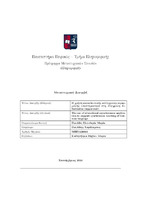Η χρήση εκπαιδευτικής ασύγχρονης εφαρμογής υποστηρικτικά στη σύγχρονη διδασκαλία γερμανικών
The use of educational asynchronous application to support synchronous teaching of German language

View/
Keywords
Asynchronous application ; Languages ; CALL ; German language ; DaF teaching ; ΤΠΕ ; ICTAbstract
This paper explores the integration of learning theories and informatics in the educational process, focusing on the teaching of German as a second foreign language within the Greek school environment.
The initial chapters present fundamental learning theories such as behaviorism, information processing theory, and cognitive types, along with instructional models including learning time, mastery learning, traditional teaching, and synchronous or asynchronous education.
Networking and distance learning, as well as the significance of autonomous learning, are also discussed.
The subsequent sections analyze the evolution of informatics in education, from its incorporation into the Unified Curriculum to the use of ICT and the development of technologies for distance teaching. Special emphasis is placed on the teaching of German, from primary to secondary school, and the use of media (Medien) in this process.
The "Digital Deutsch" application is introduced as a supportive tool for teaching German, detailing its code, usage, and potential extensions.
The conclusions summarize the findings and suggest improvements for further integrating informatics and digital media into foreign language teaching, highlighting the importance of continuous development and adaptation to modern educational needs.


